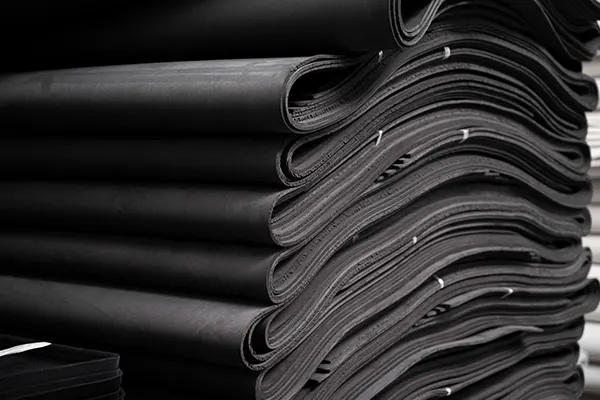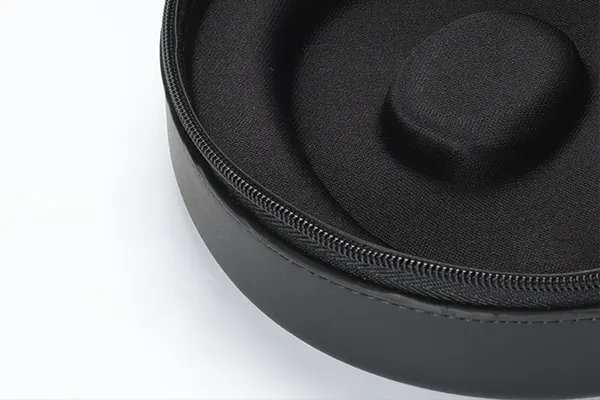Di ranah material, EVA dan PVC memiliki posisi yang signifikan karena sifatnya yang serba guna dan beragam aplikasi. Sementara kedua materi memiliki karakteristik dan keuntungan khasnya sendiri, Memahami perbedaan utama sangat penting untuk membuat keputusan berdasarkan informasi di berbagai industri. Dalam artikel ini, Kami akan mempelajari komposisi, properti, dan aplikasi EVA dan PVC. Dengan mengungkap misteri di balik bahan -bahan ini, Kami berharap dapat memberi Anda pengetahuan yang diperlukan untuk memilih materi yang tepat untuk kebutuhan spesifik Anda.
Apa itu Bahan EVA?

EVA, Akronim untuk Ethylene-Vinyl Acetate, adalah kopolimer yang dibuat oleh polimerisasi monomer etilena dan vinil asetat. Komposisi inilah yang memberi EVA sifat uniknya. Ethylene memberikan ketangguhan dan fleksibilitas yang sangat baik, sedangkan vinil asetat meningkatkan adhesi dan stabilitas termal. Lebih-lebih lagi, Rasio Ethylene to Vinyl Acetate Content Menentukan Kekerasan dan Kelembutan Bahan EVA. Umumnya, Semakin tinggi konten vinil asetat, Eva yang lebih lembut dan lebih fleksibel menjadi.
Apa itu Bahan PVC?

PVC, atau polivinil klorida, adalah polimer termoplastik sintetis yang terdiri dari unit berulang vinil klorida. Komposisi PVC memberikannya kemampuan untuk menahan berbagai kondisi lingkungan, menjadikannya salah satu bahan paling serbaguna di industri ini. Resistensi kimianya yang sangat baik, sifat mekanik, dan daya tahan telah membuat PVC menjadi pokok di berbagai sektor.
EVA vs. PVC: Proses pembuatan
Bahan EVA diproduksi melalui proses yang dikenal sebagai Polimerisasi tekanan tinggi dari monomer etilena dan vinil asetat. Proses ini melibatkan penggunaan katalis untuk memulai reaksi, menghasilkan pembentukan rantai kopolimer EVA. Komposisi bahan akhir ditentukan dengan mengontrol rasio etilen dengan vinil asetat secara hati -hati selama proses polimerisasi.
Di sisi lain, PVC diproduksi melalui proses yang disebut Polimerisasi suspensi. Dalam metode ini, monomer vinil klorida ditangguhkan dalam air, dan inisiator radikal bebas diperkenalkan untuk memulai reaksi polimerisasi. Resin PVC yang dihasilkan kemudian diproses lebih lanjut untuk mencapai karakteristik dan sifat yang diinginkan. Perlu dicatat bahwa ada teknik produksi alternatif seperti polimerisasi emulsi dan polimerisasi curah, masing -masing dengan keunggulan dan karakteristiknya sendiri.
EVA vs. PVC: Daya tahan


Eva menunjukkan ketahanan dan ketahanan yang luar biasa terhadap keausan, menjadikannya pilihan yang sangat baik untuk produk seperti kasus Eva yang sering mengalami penggunaan dan permintaan daya tahan. Struktur kopolimer EVA memberikan keseimbangan antara kekuatan dan fleksibilitas, membiarkannya menahan kekuatan eksternal tanpa deformasi atau kerusakan. Ketangguhan yang melekat memastikan bahwa bahan EVA mempertahankan bentuk dan integritasnya bahkan dalam kondisi yang keras.
Sebagai perbandingan, PVC memiliki kekuatan dan daya tahan yang luar biasa, memungkinkannya menahan beban berat dan stres fisik. Kekuatan antarmolekul PVC yang kuat memberikan resistensi yang sangat baik terhadap dampak, membuatnya cocok untuk aplikasi yang membutuhkan integritas struktural. Apakah itu pipa, kabel, atau bahan atap, Daya tahan PVC menjadikannya pilihan yang dapat diandalkan untuk solusi yang tahan lama.
EVA vs. PVC: Fleksibilitas dan Elastisitas
Fleksibilitas yang melekat pada EVA adalah salah satu keunggulan utamanya. Karena kandungan asetat vinil yang tinggi, EVA menunjukkan sifat yang lembut dan lentur, mengizinkannya Sesuai dengan berbagai bentuk dan kontur. Fleksibilitas ini menjadikan EVA bahan yang ideal untuk produk yang membutuhkan fleksibilitas dan kemudahan penggunaan, seperti alas kaki, peralatan olahraga, dan bahan pengemasan.
Sebaliknya, Elastisitas PVC memungkinkannya memulihkan bentuk aslinya setelah deformasi. Karakteristik ini membuat PVC cocok untuk aplikasi yang melibatkan pembengkokan atau peregangan, seperti struktur tiup, Selang, dan gasket. Kemampuan PVC untuk mempertahankan elastisitasnya atas berbagai suhu memperluas aplikasi potensial di industri yang beragam.
EVA vs. PVC: Ketahanan Kimia
Bahan EVA memiliki resistensi yang sangat baik terhadap berbagai bahan kimia dan pelarut. Ketahanan ini menjadikan EVA pilihan ideal untuk produk yang bersentuhan dengan berbagai zat, termasuk agen pembersih, minyak, dan asam. Selain itu, Perlawanan Eva terhadap jamur dan jamur Pertumbuhan semakin meningkatkan daya tahan dan umur panjangnya.
PVC, Mirip dengan Eva, menunjukkan resistensi kimia yang mengesankan. Itu dapat menahan paparan asam, alkali, dan zat korosif lainnya tanpa degradasi. Kualitas ini memungkinkan pemanfaatan PVC dalam aplikasi penting di mana paparan kimia menjadi perhatian, seperti wadah penyimpanan kimia, peralatan laboratorium, dan sistem pipa.
EVA vs. PVC: Tahan Air

Dalam hal ketahanan air, Eva terbukti sangat efektif. Struktur kopolimer EVA, dengan konstruksi busa sel tertutupnya, mencegah penyerapan air dan bertindak sebagai penghalang terhadap kelembaban. Properti ini menjadikan EVA bahan yang ideal untuk aplikasi waterproofing di industri seperti konstruksi, laut, dan perlengkapan luar ruangan.
Demikian pula, PVC menawarkan kemampuan waterproofing yang luar biasa. Karena permeabilitasnya yang rendah dan ketahanan terhadap penyerapan air, PVC adalah pilihan optimal untuk aplikasi di mana perlindungan kelembaban sangat penting. Dari membran atap hingga pakaian hujan, Properti Waterproofing PVC memastikan integritas dan umur panjang produk akhir.
EVA vs. PVC: Resistensi UV
Salah satu karakteristik EVA yang menarik adalah miliknya resistensi terhadap radiasi UV. Kemampuan Eva untuk menahan paparan sinar matahari yang berkepanjangan tanpa degradasi menjadikannya pilihan yang sangat baik untuk aplikasi luar ruangan. Resistensi UV memastikan bahwa bahan EVA mempertahankan sifat fisik dan estetika mereka, Bahkan saat terpapar sinar matahari yang keras untuk waktu yang lama. Kualitas ini telah menyebabkan penggunaan EVA di furnitur luar ruangan, panel surya, dan komponen otomotif.
Demikian pula, PVC memiliki Perlawanan UV yang terkenal, membuatnya cocok untuk aplikasi yang membutuhkan paparan sinar matahari yang berkepanjangan. Penambahan penstabil UV selama proses pembuatan meningkatkan ketahanan PVC terhadap radiasi UV, memastikan bahwa ia mempertahankan integritas dan penampilan strukturalnya seiring waktu. Aplikasi yang diuntungkan dari resistensi UV PVC termasuk profil jendela, pagar, dan papan nama di luar ruangan.
EVA vs. PVC: Isolasi Termal

Pameran Bahan EVA sifat isolasi termal yang luar biasa, membuat mereka sangat dicari dalam industri yang membutuhkan kontrol suhu. Struktur sel tertutup EVA mengurangi perpindahan panas, dengan demikian memberikan isolasi yang sangat baik terhadap suhu dingin dan panas. Karakteristik ini menemukan aplikasi di industri seperti pengemasan, Otomotif, dan konstruksi.
Atau, PVC memiliki tingkat isolasi termal sedang. Meskipun tidak seefektif EVA dalam hal isolasi, PVC masih menawarkan ketahanan panas yang terkenal. Kemampuannya untuk mempertahankan sifat mekaniknya pada suhu tinggi membuat PVC cocok untuk aplikasi yang melibatkan perpindahan panas, seperti isolasi listrik, pipa, dan kelongsong.
EVA vs. PVC: Biaya
Saat mempertimbangkan kelayakan ekonomi menggunakan bahan EVA, Sangat penting untuk mengevaluasi manfaat yang ditawarkan oleh materi. Sedangkan EVA mungkin memiliki a biaya awal yang lebih tinggi dibandingkan dengan bahan lain, Daya tahan yang sangat baik, fleksibilitas, dan resistensi terhadap bahan kimia dan radiasi UV berkontribusi pada efektivitas biaya jangka panjangnya. Umur panjang produk yang terbuat dari EVA memastikan pengurangan biaya perawatan dan penggantian, membuatnya menjadi layak secara ekonomi Pilihan untuk berbagai industri.
Di sisi lain, Penawaran PVC Efektivitas biaya Karena bahan baku dan biaya produksinya yang rendah. Selain itu, Daya tahan PVC dan umur panjang berkontribusi pada efektivitas biaya keseluruhannya. Kemampuan untuk menahan kondisi cuaca ekstrem dan menolak degradasi kimia mengurangi biaya perawatan dan memperpanjang umur produk yang dibuat dari PVC.
EVA vs. PVC: Dampak Lingkungan

Keramahan lingkungan Eva terletak di dalamnya Daur ulang. Bahan EVA mudah didaur ulang, memungkinkan penggunaan kembali sumber daya dan mengurangi limbah. Lebih-lebih lagi, Beberapa produsen telah mulai memproduksi EVA menggunakan sumber daya terbarukan, lebih jauh meminimalkan dampak lingkungan. Metode daur ulang dan produksi berkelanjutan yang terkait dengan EVA menjadikannya pilihan yang sadar lingkungan.
Pertimbangan lingkungan PVC berkisar pada proses pembuatannya, Toksisitas potensial, dan kemampuan daur ulang. Sementara produksi PVC menghasilkan gas klorin, Langkah -langkah diambil untuk meminimalkan pelepasannya ke lingkungan. Selain itu, Kemajuan telah dibuat dalam mengembangkan teknik daur ulang alternatif untuk PVC, memungkinkan penggunaan material yang lebih berkelanjutan. Menilai dampak lingkungan dari PVC melibatkan mempertimbangkan siklus hidup penuh material, termasuk daya tahan dan daur ulang.
EVA vs. PVC: Aplikasi dan industri
Bahan EVA menemukan aplikasi di berbagai industri, termasuk manufaktur alas kaki, barang olahraga, Otomotif, kemasan, dan bahkan perawatan kesehatan. Fleksibilitas, daya tahan, dan resistensi terhadap bahan kimia dan radiasi UV menjadikan EVA bahan serbaguna yang dapat disesuaikan dengan kebutuhan spesifik. Penggunaannya dalam sol sepatu, Bantalan busa Eva, kasus pelindung dan peralatan medis menampilkan kemampuan beradaptasi di berbagai sektor.
Aplikasi PVC menjangkau berbagai industri, penutup konstruksi, listrik, Otomotif, dan perawatan kesehatan. Daya tahan material, ketahanan terhadap bahan kimia, dan efektivitas biaya berkontribusi pada penggunaannya yang luas. PVC menemukan jalannya ke bingkai jendela, pipa, kabel, kantong darah, dan banyak produk lain yang membutuhkan kombinasi ketahanan dan keterjangkauan.
EVA vs. Bahan PVC, Mana yang Lebih Baik?
Ketika datang untuk memilih materi yang tepat untuk aplikasi tertentu, Pilihan antara Eva (Ethylene vinyl asetat) dan pvc (Polyvinyl chloride) sering muncul. Kedua bahan memiliki sifat unik, membuat mereka cocok untuk berbagai industri dan tujuan.
Manfaat materi EVA:
- Fleksibilitas dan elastisitas
- Daya tahan dan ketahanan
- Resistensi kimia
- Ketahanan air dan tahan air
- Resistensi UV
- Isolasi Termal
- Daur ulang dan keramahan lingkungan
Manfaat materi PVC:
- Kekuatan dan daya tahan
- Resistensi kimia
- Ketahanan air dan tahan air
- Resistensi UV
- Ketahanan panas yang wajar
- Efektivitas biaya
- Daur ulang dan keberlanjutan
Untuk proyek yang memprioritaskan fleksibilitas, kemudahan penggunaan, dan daur ulang, EVA mungkin pilihan yang disukai. Di sisi lain, Saat daya tahan, kekuatan, dan efektivitas biaya adalah pertimbangan utama, PVC mungkin merupakan pilihan yang lebih baik. Sangat penting untuk secara hati -hati menilai sifat -sifat unik dan keterbatasan masing -masing bahan dan mempertimbangkan bagaimana mereka selaras dengan penggunaan yang dimaksudkan untuk menentukan bahan mana yang paling cocok.
Kesimpulan
Kesimpulannya, Memahami perbedaan utama antara bahan EVA dan PVC sangat penting untuk membuat keputusan berdasarkan informasi di berbagai industri. Sementara EVA menunjukkan fleksibilitas yang luar biasa, Resistensi UV, dan daur ulang, PVC menawarkan daya tahan yang sangat baik, ketahanan terhadap bahan kimia, dan efektivitas biaya. Dengan mengevaluasi persyaratan spesifik dari setiap aplikasi, seseorang dapat memilih bahan yang paling cocok untuk mencapai hasil yang diinginkan. Apakah itu keserbagunaan EVA atau keandalan PVC, Pilihan pada akhirnya tergantung pada menemukan keseimbangan yang tepat antara fungsionalitas, umur panjang, dan kelayakan ekonomi.
















